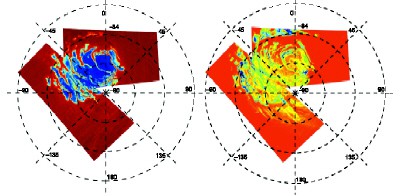Mars Express made headlines around the world in January when the European Space Agency announced to the press that the mission had found the first direct evidence for frozen water on the surface of Mars. Now, two months later, the scientific details behind the headlines have been published by Jean-Pierre Bibring of the Institut d’Astrophysique Spatiale in Orsay, near Paris, and the international team of space scientists who built the OMEGA instrument on Mars Express (Nature 428 627).

Early observations of Mars led space scientists to believe that the planet’s North Pole was composed mainly of water ice, while the South Pole contained only frozen carbon dioxide. However, recent missions – like Mars Global Surveyor and Odyssey – suggested that the South Pole might also contain frozen water. But until now, all observations had only ever provided indirect evidence for water.
Different molecules reflect sunlight at different characteristic wavelengths, and the OMEGA imaging spectrometer on Mars Express determines the composition of the planet’s surface by analysing this light in the near-infrared part of the spectrum. Bibring and co-workers identified the spectral fingerprints of water and carbon dioxide ice, and then mapped their distribution on the planet.
They found that the south pole of the planet has three distinct regions that all contain frozen water. The central ‘bright cap’ consists of a mixture of water ice and frozen carbon dioxide surrounded by a second region of almost pure frozen water. Around this – in zones tens of kilometres wide –is an area of ‘dirty’ water ice containing dust particles (see figure).
The OMEGA team hopes to make an inventory of the entire Martian surface in the coming months. The results could improve our understanding of the planet’s climate, and might also answer one of the oldest questions about the red planet: was it ever capable of sustaining life in the past, and could it host life in the future?



